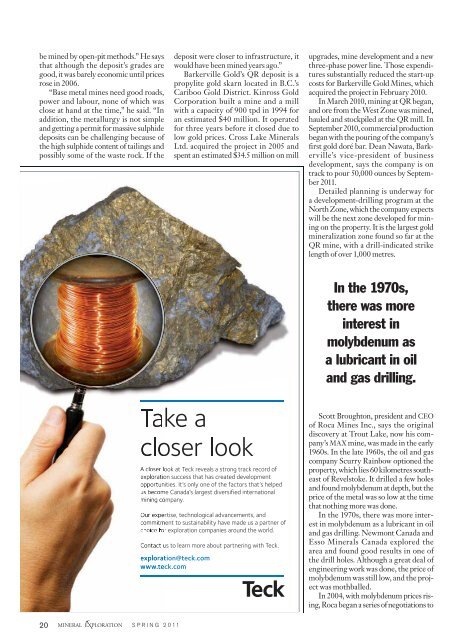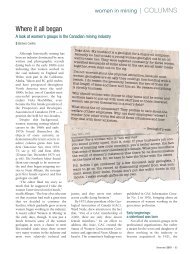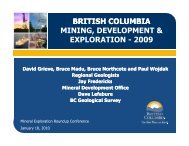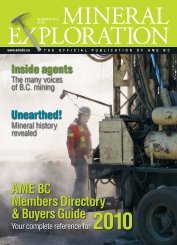Spring 2011 - The Association for Mineral Exploration British Columbia
Spring 2011 - The Association for Mineral Exploration British Columbia
Spring 2011 - The Association for Mineral Exploration British Columbia
Create successful ePaper yourself
Turn your PDF publications into a flip-book with our unique Google optimized e-Paper software.
e mined by open-pit methods.” He says<br />
that although the deposit’s grades are<br />
good, it was barely economic until prices<br />
rose in 2006.<br />
“Base metal mines need good roads,<br />
power and labour, none of which was<br />
close at hand at the time,” he said. “In<br />
addition, the metallurgy is not simple<br />
and getting a permit <strong>for</strong> massive sulphide<br />
deposits can be challenging because of<br />
the high sulphide content of tailings and<br />
possibly some of the waste rock. If the<br />
20 SPRING <strong>2011</strong><br />
deposit were closer to infrastructure, it<br />
would have been mined years ago.”<br />
Barkerville Gold’s QR deposit is a<br />
propylite gold skarn located in B.C.’s<br />
Cariboo Gold District. Kinross Gold<br />
Corporation built a mine and a mill<br />
with a capacity of 900 tpd in 1994 <strong>for</strong><br />
an estimated $40 million. It operated<br />
<strong>for</strong> three years be<strong>for</strong>e it closed due to<br />
low gold prices. Cross Lake <strong>Mineral</strong>s<br />
Ltd. acquired the project in 2005 and<br />
spent an estimated $34.5 million on mill<br />
upgrades, mine development and a new<br />
three-phase power line. Those expenditures<br />
substantially reduced the start-up<br />
costs <strong>for</strong> Barkerville Gold Mines, which<br />
acquired the project in February 2010.<br />
In March 2010, mining at QR began,<br />
and ore from the West Zone was mined,<br />
hauled and stockpiled at the QR mill. In<br />
September 2010, commercial production<br />
began with the pouring of the company’s<br />
fi rst gold doré bar. Dean Nawata, Barkerville’s<br />
vice-president of business<br />
development, says the company is on<br />
track to pour 50,000 ounces by September<br />
<strong>2011</strong>.<br />
Detailed planning is underway <strong>for</strong><br />
a development-drilling program at the<br />
North Zone, which the company expects<br />
will be the next zone developed <strong>for</strong> mining<br />
on the property. It is the largest gold<br />
mineralization zone found so far at the<br />
QR mine, with a drill-indicated strike<br />
length of over 1,000 metres.<br />
In the 1970s,<br />
there was more<br />
interest in<br />
molybdenum as<br />
a lubricant in oil<br />
and gas drilling.<br />
Scott Broughton, president and CEO<br />
of Roca Mines Inc., says the original<br />
discovery at Trout Lake, now his company’s<br />
MAX mine, was made in the early<br />
1960s. In the late 1960s, the oil and gas<br />
company Scurry Rainbow optioned the<br />
property, which lies 60 kilometres southeast<br />
of Revelstoke. It drilled a few holes<br />
and found molybdenum at depth, but the<br />
price of the metal was so low at the time<br />
that nothing more was done.<br />
In the 1970s, there was more interest<br />
in molybdenum as a lubricant in oil<br />
and gas drilling. Newmont Canada and<br />
Esso <strong>Mineral</strong>s Canada explored the<br />
area and found good results in one of<br />
the drill holes. Although a great deal of<br />
engineering work was done, the price of<br />
molybdenum was still low, and the project<br />
was mothballed.<br />
In 2004, with molybdenum prices rising,<br />
Roca began a series of negotiations to





